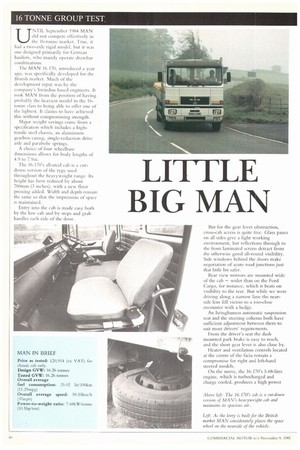LITTLE BIG MAN
Page 42

Page 43

If you've noticed an error in this article please click here to report it so we can fix it.
UNTIL September 1984 MAN did not compete effectively in the I6-tonne market. True, it had a two-axle rigid model, but it was one designed primarily for German hauliers, who mainly operate drawbar combinations.
The MAN 16.170, introduced a year ago, was specifically developed for the British market. Much of the development input was by the company's Swindon based engineers. It took MAN from the position of having probably the heaviest model in the 16tonne class to being able to offer one of the lightest. It claims to have achieved this without compromising strength.
Major weight savings come from a specification which includes a hightensile steel chassis, an aluminium gearbox casing, single-reduction drive axle and parabolic springs.
A choice of four wheelbase dimensions allows for body lengths of 4,9 to 7.9m.
The 16.170's all-steel cab is a cutdown version of the type used throughout the heavyweight range. Its height has been reduced by about 760mm (3 inches), with a new floor pressing added. Width and depth remain the same so that the impression of space is maintained.
Entry into the cab is made easy both by the low cab and by steps and grab handles each side of the door. But for the gear lever obstruction, cross-cab access is quite free. Glass panes on all sides give a light working environment, but reflections through to the front laminated screen detract from the otherwise good all-round visibility. Side windows behind the doors make negotiation of acute road junctions just that little bit safer.
Rear view mirrors are mounted wide of the cab — wider than on the Ford Cargo, for instance, which it beats on visibility to the rear. But while we were driving along a narrow lane the nearside lens fell victim to a too-close encounter with a hedge.
An Isringhausen automatic suspension seat and the steering column both have sufficient adjustment between them to suit most drivers' requirements.
From the driver's seat the dash mounted park brake is easy to reach, and the short gear lever is also close by.
[eater and ventilation controls located at the centre of the facia remain a compromise for right and left-hand steered models.
On the move, the 16.170's 5.68-litre engine, which is turbocharged and charge cooled, produces a high power
output of I25kW (168hp) at a relatively high 2,80Orpm. Torque, though, is unexceptional. The engine maintains a maximum level of 550Nm (4051bft) over a 5011 rev hand from 1,700 down to 1,20Orpm.
This is said to be partly due to tuned induction resonance. This is a method adopted by MAN to improve the breathing of the engine. The prescribed. driving style with it is to contain engine speed to the litnits of maximum torque as little or no benefit is claimed in performance with higher engine revs.
The fast rear axle with a ratio of 4.86 to 1 as standard gives a geared speed of 115km/h (71.4mph) so that motorway speeds are accommodated at less than 2.400rpm. At 64km/h (4(1mph) the engine pulls strongly and continues to do so down to 1,200rpm.
Such flexibility makes driving a relaxed affair removing some of the urgency in maintaining fast journey times. Overall, the MAN 16.170 proved to be on the slow side, taking 20 minutes longer to complete our test route than the fastest vehicle in the group. Its journey time was what we would have expected of less powerful vehicles.
One area where it was not slow, however, was the timed hill climbs. The gearbox gave a smooth, clean action allowing the vehicle to pull away from rest using second gear in normal conditions.
Neither A-road nor motorway fuel consumption figures managed to impress, though, with an overall return of only 25.021it/100km (11.29mpg).
MAN was clearly disappointed with this result, but offered no explanation.
Braking is progressive and responsive. A high-pressure air storage system saves the weight of two air tanks normally required.
The foot operated exhaust brake does little to improve braking performance, except when used in conjunction with the lower gear ratios. Soft parabolic leaf springs give a good level ride, but without the optional front anti-roll bar fitted the vehicle tends to lean on corners.
Regarding maintenance, all areas requiring daily attention are easily accessible. The oil filler and clutch fluid reservoir are reached via the front hinged grille; the windscreen washer reservoir and header rank are mounted to the rear of the cab.
For full service access the cab may be tilted hydraulically to 52 degrees. It has an automatic locking system with a warning light on the dash. Operation of the hydraulic pump, which is mounted on the side of the chassis, is inhibited by the side guards. At !'.20,914 for the longest wheelbase variant, MAN has produced an attractively priced vehicle built to high standards and giving a high body/payload allowance. In-cab noise levels are low only 7)d15(A) at 64km/h (40mph) rising to 79d11(A) at 97km/h (60mph).












































































































































